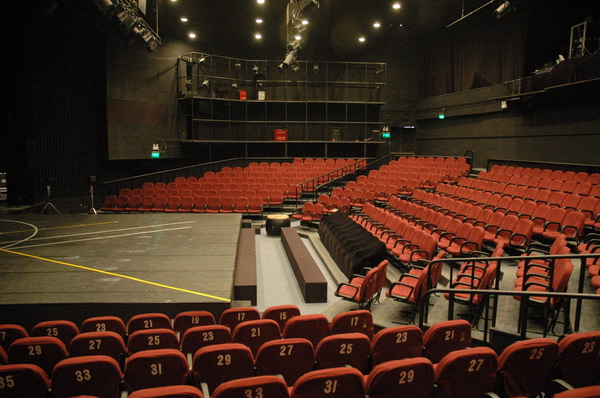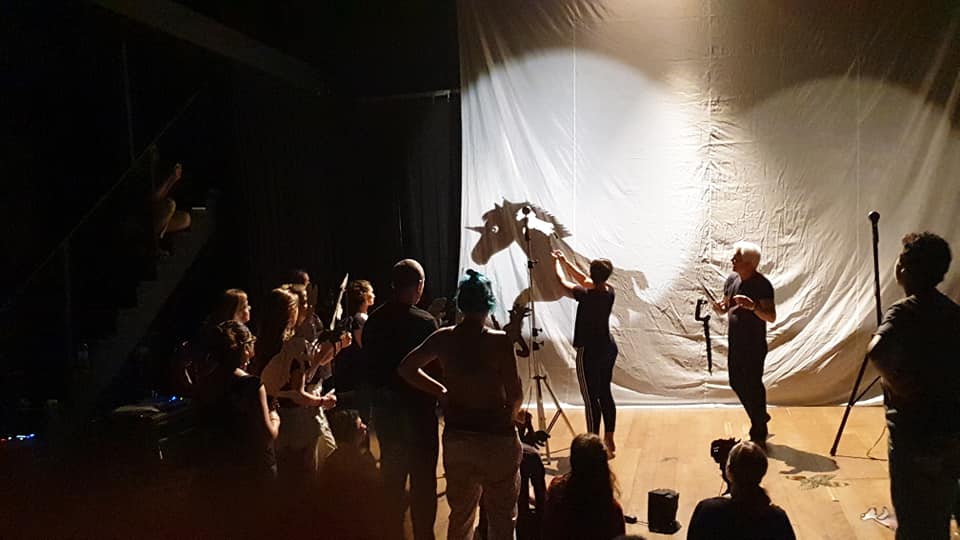The 4th International Conference on Training in The Arts of Puppetry: “The place of tradition in contemporary puppetry. Bridges, not boarders”. September 22-25, 2020. Beijing, China.
Context
Traditional puppet theater in Asia, such as the Indonesian, Indian, and Chinese shadows, the Chinese hand and rod puppet theater, the Bunraku, or in Europe such as the Pulcinella family, the puppi Siciliani, the Czech rod marionettes – to mention only a part of this vast world cultural heritage – presents defined forms, with fixed dramaturgical structures and definite gestural vocabularies. In the traditional repertoire, stories and characters change while aesthetics and impact on the audience remain the same. The type of puppets – their physiognomy, their color pallet and their dynamics – is in perfect harmony with the type of dramaturgy that has been created for them. The puppeteers are committed to achieving the performance virtuosity so much appreciated by the public and the differences between artists are expressed in fine performing nuances and in the fine art aspect of the puppets. The staging, even when it is innovative, follows the codes of each of the forms. With respect to traditional puppet theater training, knowledge is often transmitted through master-student learning.
Contemporary Puppet Theater is situated at the other pole of creation. Inspired by the potential of its new expressive means, artists from the fields of dance, mime and the visual arts turned their interest to puppetry. This encounter has given birth to new and spectacular forms, which brought together, the puppet and the actor, which invented the “body masks” and the fictional or imaginary body, and which meet at the intersection of puppetry, acting and mime performance. The imaginary invaded the plateau. Contemporary theater seldom starts with a text written for the stage. Its sources are often a literary text, a musical piece, a theme, an idea, and a desire to question an important subject. The dramaturgical structure is created for the show; writing and staging work in a relationship of complicity, evolving together until the end of the creative process.
Could we talk about borders between eastern and western puppet theater? Could we build bridges between them? What about the borders between traditional and contemporary forms. Could they exist without exist without the each other?
After having discussed the definition of puppetry and puppet theater in 2015 in Charleville-Mezieres, France; the pedagogy and the links between traditional and contemporary theater in 2017 in Targoviste, Romania; the different aspects of the current notion of directing in 2019 in Florianópolis, Brasil; the Fourth International Conference on Training in the Arts of Puppetry will take place in Beijing, China. The meeting is organized by the UNIMA Training Commission in collaboration with the Central Academy of Drama in Beijing, and with the participation of researchers, practitioners, pedagogues and students. The participants will examine different aspects of traditional and contemporary puppet theatre, their social function, and the emotional impact on the public in the world and particularly in Asia.
Subject
1. Overview
Does innovation compromise the traditional heritage? How does the contemporary society regard traditional theatre?
How do these questions affect training for puppeteers?
“Contemporary puppetry” is born of a profusion of contemporary forms, produced with an overflowing inventiveness. The main preoccupation which drives the artists is to create new forms of communication in order to better address the contemporary public.
How do artists, historians, and theoreticians perceive a potential development in the arts of puppetry in relation to the socio-cultural changes in different countries? Thus, a new question appears: how to approach professional training in the perspective of a theatre in permanent evolution?
2. Puppetry training
Could the training of traditional forms of puppetry coexist with the training of contemporary forms? How? What knowledge could they bring to each other? What could be the training philosophy and methodology for puppet theatre today in the different countries, especially in Asia? What relation to create between traditional forms and contemporary forms, between traditional artists and contemporary artists? What do we have to learn from each other? What problems arise from this approach?
We intend:
- To explore the influences of Eastern Theatre on Western Theatre and vice versa in the 20th and 21st century.
- To explore the links between tradition and contemporary forms.
- To explore the pedagogy of new and old forms of training.
For this purpose, we propose work topics such as:
- Conference on the evolution of the performing and staging in theatre, its goals, its challenges, and the relationship between staging and dramaturgy. Comparative historiography.
- The presentation of unique creative processes, linked to artistic personalities.
- Practical workshops that show various pedagogical approaches to teaching puppetry.
- Debates and round tables with the guests in the presence and with the participation of students and teaching artists.
The Central Academy of Drama, Beijing, will host the conference.
Speakers
- Stage directors and puppeteers teaching artists, who a personal vision of training.
- Directors of Training Programs devoted to the puppetry arts in formal and informal institutions.
Dates
Sep 22 – 25, 2020
Place
The Central Academy of Drama, Champing Campus. Beijing, CHINA.

Note:
As in the former meetings in France, Romania, and Brazil, all the conferences, round tables, and practical workshops, will be recorded and uploaded on different web sites such as Youtube, Vimeo, Facebook, etc., or on similar platforms in China, linked to the website of UNIMA. The Central Academy of Drama will publish a book with the lectures and workshops given in the meeting.


Hello !
I’m Eduardo Felix , director of Pigmalião Escultura que Mexe, from Brazil.
I’d like to know if it’s possible to subscribe shows or workshops for the conference. We have a big repertoire and a dream to go to China !
Our website is pigmaliao.com.
Best regards looking forward
Eduardo
Olá Eduardo!
El encuentro pasará al 2021.
Por favor, comunícate por privado a: professional-training@unima.org
Un fuerte abrazo,
Tito Lorefice
Dear Sir/madam,
We are a visual theatre company and we are interested to submit a proposal for a workshop. Could we have a bit of more information?
I look forward to hearing from you
Mayra Stergiou
Artistic Director
Hello Mayra,
Thank you for your interest.
The meeting will be reschedule to 2021, exact date must be confirmed in near future.
Please contact : professional-training@unima.org
Best wishes,
Tito Lorefice
Hi
I am really interested to take part in the conference. I have been teaching Puppetry at Nottingham Trent University for 15 years. I myself was a puppeteer before this, working independently as well as the Company Philippe Genty.
Hello Sean,
Thank you for your interest.
The meeting will be reschedule to 2021, exact date must be confirmed in near future.
Please contact : professional-training@unima.org for details.
Regards,
Tito Lorefice
Envienmelo por favor
I would love to attend the conference. Please keep me informed
Hello Benjamin Ho Kah Wai,
Thank you for your interest.
The meeting will be reschedule to 2021, exact date must be confirmed in near future.
Please contact : professional-training@unima.org
Regards,
Tito Lorefice
Thank you for announcing this well in advance. It is my intention to participate.
Cheers,
Bart. P. Roccoberton, Jr.
Director, Puppet Arts Program
University of Connecticut
Hello dear Bart,
The meeting will be reschedule to 2021, exact date must be confirmed in near future.
Looking forward to welcome you in the meeting.
Best wishes,
Tito Lorefice
One of our most active commissions of unima congragulations to all
Regards
Dadi
Thank you, Dadi!
Hello dear,
It feels great to know about the conference. We are a team named “inventor’s puppet” practicing puppet for 15 years in Bangladesh.
We are looking forword to know more about the procedure of attending the conference. Please share some information.
Hello Suvankar,
Thank you for your interest.
The meeting will be reschedule to 2021, exact date must be confirmed in near future.
Please contact : professional-training@unima.org for details.
Regards,
Tito Lorefice
Hi, Vivek here from India
I love to be part of the event. Please share information in detail.
Hello Vivek Shukla,
Thank you for your interest.
The meeting will be reschedule to 2021, exact date must be confirmed in near future.
Please contact : professional-training@unima.org for details.
Regards,
Tito Lorefice
I am very interested. I am a dalang and creator of Wayang Listrik, cinematic shadow theater
Hello Larry,
The meeting will be reschedule to 2021, exact date must be confirmed in near future.
Please contact : professional-training@unima.org.
Regards,
Tito Lorefice
hello,
hello, I want to know the person in charge of this event to propose a pedagogical action of the puppet in strong relation with your theme: traditions and contemporary, porosity between occident and orient.Je name is Sébastien Vuillot and I am artistic director of Tsurukam Company Franco-japonese.
Bonjour Sébastien,
S’il vous plaît contactez Kata Czató, Anurupa Roy óu Tito Lorefice:
professional-training@unima.org.
Bien à toi
tito
Dear Organisers,
I am interested in the conference and I would like to submit a proposal to take part if possible. Can you please forward me further information on how to get involved or how to attend the event.
With many thanks
Jose Navarro Theatre
Hola José,
Muchas gracias por tu interés.
El evento ha sido re agendado para el 2021, con fecha a confirmar.
Por favor, contacta con professional-training@unima.org.
Un saludo,
Tito
I wish to attend this conference. Puppetry as a pedagical tool is my main working area, at the moment, and the research at the university. I have created a Pritney method with a pony puppet, and I wish to attend your conference next year 2020. This conference is great news! Looking forward to it. Best regards Pirjo
Hello Pirjo,
The meeting will be reschedule to 2021, exact date must be confirmed in near future.
Please contact : professional-training@unima.org.
Regards,
Tito Lorefice
Spare Parts Puppet Theatre in Western Australia would love to be involved. We currently have a tertiary train course in puppetry with the Western Australian Academy of Performing Arts (WAAPA) and other artist training programs.
Please keep us informed
Philip Mitchell
Artistic Director
Hello Philip Mitchell!
Wonderful if you could come to the meeting.
The meeting will be reschedule to 2021, exact date must be confirmed in near future.
Please contact : professional-training@unima.org.
Regards,
Tito Lorefice
Hola, saludos desde Guatemala, me encantaria tener noticias cuando se abra la convocatoria, mi correo es komosteatros@gmail.com agradecere mucho si me comparten la informacion. Gracias
I eagerly want to join the conference. I’m a Puppeteer of Sisimpur Bangladesh co-production of Sesame Street. I’m also member and founder of Inventor’s Puppet. How can I join the conference ?
I’m Ben Ho, the artistic director of Paper Monkey Theatre in Singapore and also the president of UNIMA Singapore. Our website: http://www.papermonkey.com.sg . This topic is of great relevance to us as we in Singapore is a mixture of Western and Eastern values and traditional. We would love to explore and share our works with others. Could you forward detail information of the event ASAP so we could raise funds to attend. Thank you.